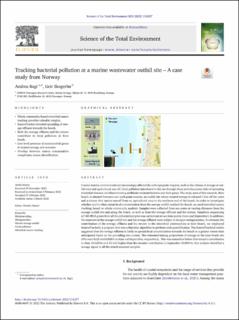| dc.contributor.author | Bagi, Andrea | |
| dc.contributor.author | Skogerbø, Geir | |
| dc.date.accessioned | 2022-06-13T13:04:53Z | |
| dc.date.available | 2022-06-13T13:04:53Z | |
| dc.date.created | 2022-02-08T09:40:12Z | |
| dc.date.issued | 2022 | |
| dc.identifier.issn | 0048-9697 | |
| dc.identifier.uri | https://hdl.handle.net/11250/2998556 | |
| dc.description.abstract | Coastal marine environments are increasingly affected by anthropogenic impacts, such as the release of sewage at outfall sites and agricultural run-off. Fecal pollution introduced to the sea through these activities poses risks of spreading microbial diseases and disseminating antibiotic resistant bacteria and their genes. The study area of this research, Bore beach, is situated between two such point sources, an outfall site where treated sewage is released 1 km off the coast and a stream that carries run-off from an agricultural area to the northern end of the beach. In order to investigate whether and to what extent fecal contamination from the sewage outfall reached the beach, we used microbial source tracking, based on whole community analysis. Samples were collected from sea water at varying distances from the sewage outfall site and along the beach, as well as from the sewage effluent and the stream. Amplicon sequencing of 16S rRNA genes from all the collected samples was carried out at two time points (June and September). In addition, the seawater at the sewage outfall site and the sewage effluent were subject to shotgun metagenomics. To estimate the contribution of the sewage effluent and the stream to the microbial communities at Bore beach, we employed SourceTracker2, a program that uses a Bayesian algorithm to perform such quantification. The SourceTracker2 results suggested that the sewage effluent is likely to spread fecal contamination towards the beach to a greater extent than anticipated based on the prevailing sea current. The estimated mixing proportions of sewage at the near-beach site (P4) were 0.22 and 0.035% in June and September, respectively. This was somewhat below that stream's contribution in June (0.028%) and 10-fold higher than the stream's contribution in September (0.004%). Our analysis identified a sewage signal in all the tested seawater samples. | en_US |
| dc.language.iso | eng | en_US |
| dc.rights | Navngivelse 4.0 Internasjonal | * |
| dc.rights.uri | http://creativecommons.org/licenses/by/4.0/deed.no | * |
| dc.title | Tracking bacterial pollution at a marine wastewater outfall site – A case study from Norway | en_US |
| dc.title.alternative | Tracking bacterial pollution at a marine wastewater outfall site – A case study from Norway | en_US |
| dc.type | Journal article | en_US |
| dc.type | Peer reviewed | en_US |
| dc.rights.holder | © 2022 The Authors | en_US |
| dc.description.version | publishedVersion | en_US |
| cristin.ispublished | true | |
| cristin.fulltext | original | |
| cristin.qualitycode | 2 | |
| dc.identifier.doi | 10.1016/j.scitotenv.2022.154257 | |
| dc.identifier.cristin | 1998898 | |
| dc.source.journal | Science of the Total Environment | en_US |
| dc.source.volume | 829 | en_US |

